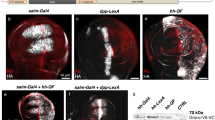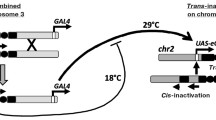Abstract
Transvection is a phenomenon of interallelic communication whereby enhancers of one allele can activate a promoter located on the homologous chromosome. It has been shown for many independent genes that enhancers preferentially act on the cis-linked promoter, but deletion of this promoter allows the enhancers to act in trans. Here, we tested whether this cis-preference in the enhancer–promoter interaction could be reconstituted outside of the natural position of a gene. The yellow gene was chosen as a model system. Transgenic flies were generated that carried the yellow gene modified by the inclusion of the strategically placed recognition sites for the Cre and Flp recombinases. To facilitate transvection, an endogenous Su(Hw) insulator (1A2) or gypsy insulator was placed behind the yellow gene. Independent action of the recombinases produced a pair of derivative alleles, one containing the promoter-driven yellow gene, and the other, the enhancers and promoter that failed to produce a functional yellow protein. As a result, we observed strong transvection in many genomic regions, suggesting that a complete cis-preference of the enhancer–promoter interactions is mainly restricted to genes in their natural loci.








Similar content being viewed by others
References
Bateman JR, Johnson JE, Locke MN (2012a) Comparing enhancer action in cis and in trans. Genetics 191:1143–1155
Bateman JR, Larschan E, D’Souza R, Marshall LS, Dempsey KE, Johnson JE, Mellone BG, Kuroda MI (2012b) A genome-wide screen identifies genes that affect somatic homolog pairing in Drosophila. G3 (Bethesda) 2:731–740
Bender W, Akam M, Karch F, Beachy PA, Peifer M, Spierer P, Lewis EB, Hogness DS (1983) Molecular genetics of the Bithorax complex in Drosophila melanogaster. Science 221:23–29
Butler JE, Kadonaga JT (2001) Enhancer–promoter specificity mediated by DPE or TATA core promoter motifs. Genes Dev 15:2515–2519
Cai HN, Zhang Z, Adams JR, Shen P (2001) Genomic context modulates insulator activity through promoter competition. Development 128:4339–4347
Casares F, Bender W, Merriam J, Sanchez-Herrero E (1997) Interactions of Drosophila ultrabithorax regulatory regions with native and foreign promoters. Genetics 145:123–137
Chen JL, Huisinga KL, Viering MM, Ou SA, Wu CT, Geyer PK (2002) Enhancer action in trans is permitted throughout the Drosophila genome. Proc Natl Acad Sci U S A 99:3723–3728
Choi OR, Engel JD (1988) Developmental regulation of beta-globin gene switching. Cell 55:17–26
Dekker J, Mirny L (2016) The 3D genome as moderator of chromosomal communication. Cell 164:1110–1121
Duncan IW (2002) Transvection effects in Drosophila. Annu Rev Genet 36:521–556
Erokhin M, Davydova A, Kyrchanova O, Parshikov A, Georgiev P, Chetverina D (2011) Insulators form gene loops by interacting with promoters in Drosophila. Development 138:4097–4106
Fritsch C, Ploeger G, Arndt-Jovin DJ (2006) Drosophila under the lens: imaging from chromosomes to whole embryos. Chromosom Res 14:451–464
Frosi Y, Haering CH (2015) Control of chromosome interactions by condensin complexes. Curr Opin Cell Biol 34:94–100
Fujioka M, Mistry H, Schedl P, Jaynes JB (2016) Determinants of chromosome architecture: insulator pairing in cis and in trans. PLoS Genet 12(2):e1005889. doi:10.1371/journal.pgen.1005889 eCollection
Fung JC, Marshall WF, Dernburg A, Agard DA, Sedat JW (1998) Homologous chromosome pairing in Drosophila melanogaster proceeds through multiple independent initiations. J Cell Biol 141:5–20
Gemkow MJ, Verveer PJ, Arndt-Jovin DJ (1998) Homologous association of the Bithorax complex during embryogenesis: consequences for transvection in Drosophila melanogaster. Development 125:4541–4552
Geyer PK, Corces VG (1987) Separate regulatory elements are responsible for the complex pattern of tissue-specific and developmental transcription of the yellow locus in Drosophila melanogaster. Genes Dev 1:996–1004
Geyer PK, Green MM, Corces VG (1990) Tissue-specific transcriptional enhancers may act in trans on the gene located in the homologous chromosome: the molecular basis of transvection in Drosophila. EMBO J 9:2247–2256
Ghavi-Helm Y, Klein FA, Pakozdi T, Ciglar L, Noordermeer D, Huber W, Furlong EE (2014) Enhancer loops appear stable during development and are associated with paused polymerase. Nature 512:96–100
Gohl D, Muller M, Pirrotta V, Affolter M, Schedl P (2008) Enhancer blocking and transvection at the Drosophila apterous locus. Genetics 178:127–143
Golic KG, Lindquist S (1989) The FLP recombinase of yeast catalyzes site-specific recombination in the Drosophila genome. Cell 59:499–509
Golovnin A, Biryukova I, Romanova O, Silicheva M, Parshikov A, Savitskaya E, Pirrotta V, Georgiev P (2003) An endogenous Su(Hw) insulator separates the yellow gene from the Achaete-scute gene complex in Drosophila. Development 130:3249–3258
Golovnin A, Melnick E, Mazur A, Georgiev P (2005) Drosophila Su(Hw) insulator can stimulate transcription of a weakened yellow promoter over a distance. Genetics 170:1133–1142
Hartl TA, Smith HF, Bosco G (2008) Chromosome alignment and transvection are antagonized by condensin II. Science 322:1384–1387
Hendrickson JE, Sakonju S (1995) Cis and trans interactions between the iab regulatory regions and abdominal-A and abdominal-B in Drosophila melanogaster. Genetics 139:835–848
Hiraoka Y, Dernburg AF, Parmelee SJ, Rykowski MC, Agard DA, Sedat JW (1993) The onset of homologous chromosome pairing during Drosophila melanogaster embryogenesis. J Cell Biol 120:591–600
Hoess RH, Wierzbicki A, Abremski K (1986) The role of the loxP spacer region in P1 site-specific recombination. Nucleic Acids Res 14:2287–2300
Joyce EF, Williams BR, Xie T, Wu CT (2012) Identification of genes that promote or antagonize somatic homolog pairing using a high-throughput FISH-based screen. PLoS Genet 8:e1002667
Kennison JA, Southworth JW (2002) Transvection in Drosophila. Adv Genet 46:399–420
Kravchenko E, Savitskaya E, Kravchuk O, Parshikov A, Georgiev P, Savitsky M (2005) Pairing between gypsy insulators facilitates the enhancer action in trans throughout the Drosophila genome. Mol Cell Biol 25:9283–9291
Krivega M, Savitskaya E, Krivega I, Karakozova M, Parshikov A, Golovnin A, Georgiev P (2010) Interaction between a pair of gypsy insulators or between heterologous gypsy and Wari insulators modulates Flp site-specific recombination in Drosophila melanogaster. Chromosoma 119:425–434
Kyrchanova O, Maksimenko O, Stakhov V, Ivlieva T, Parshikov A, Studitsky VM, Georgiev P (2013) Effective blocking of the white enhancer requires cooperation between two main mechanisms suggested for the insulator function. PLoS Genet 9(7):e1003606
Levine M, Cattoglio C, Tjian R (2014) Looping back to leap forward: transcription enters a new era. Cell 157:13–25
Lewis EB (1954) The theory and application of a new method of detecting chromosomal rearrangements in Drosophila melanogaster. Am Nat 88:225–239
Markstein M, Pitsouli C, Villalta C, Celniker SE, Perrimon N (2008) Exploiting position effects and the gypsy retrovirus insulator to engineer precisely expressed transgenes. Nat Genet 40:476–483
Martin M, Meng YB, Chia W (1989) Regulatory elements involved in the tissue-specific expression of the yellow gene of Drosophila. Mol Gen Genet 218:118–126
Martinez-Laborda A, Gonzalez-Reyes A, Morata G (1992) Trans regulation in the Ultrabithorax gene of Drosophila: alterations in the promoter enhance transvection. EMBO J 11:3645–3652
McKee BD (2004) Homologous pairing and chromosome dynamics in meiosis and mitosis. Biochim Biophys Acta 1677:165–180
Mellert DJ, Truman JW (2012) Transvection is common throughout the Drosophila genome. Genetics 191:1129–1141
Mifsud B, Tavares-Cadete F, Young AN, Sugar R, Schoenfelder S, Ferreira L, Wingett SW, Andrews S, Grey W, Ewels PA, et al. (2015) Mapping long-range promoter contacts in human cells with high-resolution capture hi–C. Nat Genet 47:598–606
Morris JR, Chen JL, Geyer PK, Wu CT (1998) Two modes of transvection: enhancer action in trans and bypass of a chromatin insulator in cis. Proc Natl Acad Sci U S A 95:10740–10745
Morris JR, Chen J, Filandrinos ST, Dunn RC, Fisk R, Geyer PK, Wu C (1999a) An analysis of transvection at the yellow locus of Drosophila melanogaster. Genetics 151:633–651
Morris JR, Geyer PK, Wu CT (1999b) Core promoter elements can regulate transcription on a separate chromosome in trans. Genes Dev 13:253–258
Morris JR, Petrov DA, Lee AM, Wu CT (2004) Enhancer choice in cis and in trans in Drosophila melanogaster: role of the promoter. Genetics 167:1739–1747
Nguyen HQ, Nye J, Buster DW, Klebba JE, Rogers GC, Bosco G (2015) Drosophila casein kinase I alpha regulates homolog pairing and genome organization by modulating condensin II subunit cap-H2 levels. PLoS Genet 11(2):e1005014
Ohtsuki S, Levine M, Cai HN (1998) Different core promoters possess distinct regulatory activities in the Drosophila embryo. Genes Dev 12:547–556
Parnell TJ, Viering MM, Skjesol A, Helou C, Kuhn EJ, Geyer PK (2003) An endogenous suppressor of hairy-wing insulator separates regulatory domains in Drosophila. Proc Natl Acad Sci U S A 100:13436–13441
Roseman RR, Pirrotta V, Geyer PK (1993) The su(Hw) protein insulates expression of the Drosophila melanogaster white gene from chromosomal position-effects. EMBO J 12:435–442
Schoborg T, Kuruganti S, Rickels R, Labrador M (2013) The Drosophila gypsy insulator supports transvection in the presence of the vestigial enhancer. PLoS One 8:e81331
Sipos L, Mihaly J, Karch F, Schedl P, Gausz J, Gyurkovics H (1998) Transvection in the Drosophila Abd-B domain: extensive upstream sequences are involved in anchoring distant cis-regulatory regions to the promoter. Genetics 149:1031–1050
Smith HF, Roberts MA, Nguyen HQ, Peterson M, Hartl TA, Wang XJ, Klebba JE, Rogers GC, Bosco G (2013) Maintenance of interphase chromosome compaction and homolog pairing in Drosophila is regulated by the condensin cap-h2 and its partner Mrg15. Genetics 195:127–146
Southworth JW, Kennison JA (2002) Transvection and silencing of the Scr homeotic gene of Drosophila melanogaster. Genetics 161:733–746
Verrijzer CP, Tjian R (1996) TAFs mediate transcriptional activation and promoter selectivity. Trends Biochem Sci 21:338–342
Wallace HA, Bosco G (2013) Condensins and 3D organization of the interphase nucleus. Curr Genet Med Rep 1:219–229
Wallace HA, Klebba JE, Kusch T, Rogers GC, Bosco G (2015) Condensin II regulates interphase chromatin organization through the Mrg-binding motif of cap-H2. G3 (Bethesda) 5(5):803–817
Williams BR, Bateman JR, Novikov ND, Wu CT (2007) Disruption of topoisomerase II perturbs pairing in Drosophila cell culture. Genetics 177:31–46
Acknowledgments
We are grateful to N.A. Gorgolyuk for his help in preparing the manuscript.
Author information
Authors and Affiliations
Corresponding authors
Ethics declarations
Funding
This work was supported by the Russian Science Foundation, project no. 14-24-00166.
Conflict of interest
The authors declare that they have no conflict of interest.
Ethical Approval
All applicable international, national, and/or institutional guidelines for the care and use of animals were followed. This article does not contain any studies with human participants performed by any of the authors.
Electronic supplementary material
ESM 1
(PDF 246 kb)
Rights and permissions
About this article
Cite this article
Kravchuk, O., Kim, M., Klepikov, P. et al. Transvection in Drosophila: trans-interaction between yellow enhancers and promoter is strongly suppressed by a cis-promoter only in certain genomic regions. Chromosoma 126, 431–441 (2017). https://doi.org/10.1007/s00412-016-0605-6
Received:
Revised:
Accepted:
Published:
Issue Date:
DOI: https://doi.org/10.1007/s00412-016-0605-6




